U.S. Department of Transportation
Federal Highway Administration
1200 New Jersey Avenue, SE
Washington, DC 20590
202-366-4000

U.S. Department of Transportation
Federal Highway Administration
View the PDF Version [852 KB]
In this issue:
Toolbox of Countermeasures and their Potential Effectiveness for Pedestrian Crashes
Secretary of Transportation Hosts Two Bike Safety Summits
Upcoming Webinar on Systematic Safety Project Selection Tool

FHWA just completed revising the popular Safer Journey resource that is geared towards school aged children. FHWA first developed Safer Journey 13 years ago. It was designed as an interactive CD that takes the user through various pedestrian safety scenarios encountered every day. The target audience was middle school-aged kids, and Safer Journey proved to be a very popular resource with over 100,000 copies given out over the years.
Three years ago, the FWHA Safety Office developed a Pedestrian Safety Strategic Plan to chart FHWA's course over the next decade in developing research, tools and resources that will make the biggest impact on the pedestrian safety problem. As part of that, a user feedback survey was conducted to gather information on how to best make improvements to various resources developed over the years; Safer Journey was one of them.
The revised Safer Journey is now only available on the web and it is updated to reflect current times and technology. There are versions for kids ages 5-9, 10-14, and 15-18. Each version was tested and tweaked with children in those age groups, as well as educators and others who will be using the tools.
Three videos – one for each of three age groups – accompanied by a quiz or discussion and an educator's resource library can be used as an introduction to pedestrian safety skills or to augment a comprehensive curriculum.
Safer Journey helps educators, parents and others who care about pedestrian safety get the conversation started with children and youth.
Contributed by Becky Crowe
The Moving Ahead for Progress in the 21st Century (MAP-21) went into effect Oct 1, 2012 and includes Section 1112(a), a Special Rule to consider Older Drivers and Pedestrians (over the age of 65). The Special Rule requires states with an increase in traffic fatalities and serious injuries per capita for drivers and pedestrians over the age of 65, during the most recent 2-year period, to include strategies to address the increase in their Strategic Highway Safety Plan.
When developing strategies, States are asked to take into account the recommendations included in the FHWA publication: Highway Design Handbook for Older Drivers and Pedestrians (FHWA-RD-01-103). The Interim Guidance on the Older Drivers and Pedestrians Special Rule can be accessed on the FHWA MAP-21 website.
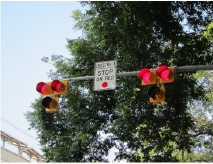 Pedestrian Hybrid Beacon–one of the new countermeasures included in the Toolbox of Countermeasures. |
In April 2013, the U.S. Department of Transportation (DOT)co-sponsored two Regional Bicycle Safety Summits with the City of Tampa on April 11 and with the City of Minneapolis, the Minnesota Department of Transportation and Transit for Livable Communities on April 29.
The Summits were highly anticipated events that generated a great deal of interest in the bicycle safety and advocacy community. Over 200 people attended each Summit. The highlight of the summits was a National Bike Safety Rally with Secretary Ray LaHood (in Tampa), the Mayor, and the local hosts emphasizing the importance of bike safety and the need for action in this area.
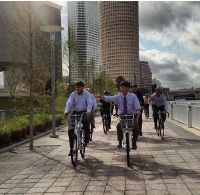
Above: Biking with Tampa Mayor Bob Buckthorn.
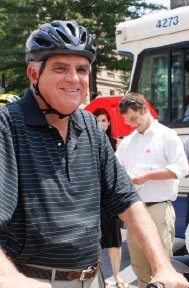
Each summit also included technical sessions with expert panels describing innovative bicycle safety solutions from their community, state or region. The presentations prompted interactive discussions among participants and the regional and national experts about bicyclist safety. Technical topics included: engineering, planning, evaluation, enforcement, education and encouragement
The summits included a Bicycle Safety Expo for over a dozen local and national organizations to provide information about best practices, training opportunities, and other materials. The Tampa Expo included a bicycle skills training course. The Minneapolis event ended with guided bike tours highlighting innovative bicycle infrastructure around the city. The Expos included hands-on interactive activities and information including walkability/bikability checklists, bike safety training, bike helmet fittings and equipment demonstrations, and safety campaigns.
Some lessons learned by DOT from the events include:
For more information, contact Lilly Shoup at 202-366-8134 or lilly.shoup@dot.gov.
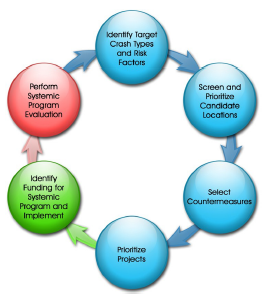 |
On May 28 at 1:00-2:30 east-ern time, the FHWA Safety Office and the Pedestrian and Bike Information Center (PBIC) will host a webinar providing an overview of the Systemic Safety Project Selection Tool and the potential application to address pedestrian safety issues. The Systemic Safety Project Selection Tool outlines a risk-based approach to safety management to complement traditional "hot spot" analyses.
The tool presents a step-by-step process to conduct systemic safety planning to identify highway safety improvement projects for widespread implementation on particular system of roads. The tool also presents a mechanism to deter-mine an appropriate balance of investments between site-specific and systemic safety improvements.
A case study will be used to show the potential application of the systemic approach to safety to target pedestrian safety issues. The case study will illustrate potential risk factors associated with pedestrian crashes, and how those risk factors can be used to identify and prioritize pedestrian safety projects for implementation. The presenters will be Karen Scurry of FHWA's Office of Safety and Howard Preston of CH2M Hill.
Click here for registration information.
Shana Baker
Shana Baker is the new Liveability Team Leader in the Office of Human Environment. Shana takes over the job of Gabe Rousseau, who joined the Office of Safety Technologies as the new team leader for Safety Operations on January 13.
Shana previously served as a community planner on the Livability Team where she advanced awareness of livability within the Federal transportation planning process. She has led various working groups in support of the Interagency Partnership for Sustainable Communities consisting of the DOT/Department of Housing and Urban Development (HUD)/and Environmental Planning Agency (EPA). Shana has extensive planning experience with integrating freight in the metropolitan planning process, working with geographically assigned Division Offices to assess statewide and metropolitan planning program stewardship and oversight needs, and working with FHWA's Florida Division Office where she served as a transportation planner supporting 25 metropolitan planning organizations and the Florida Department of Transportation.
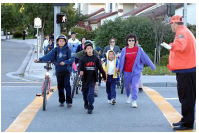
Shana obtained a Master's degree in Urban Planning from the University of Akron and the a Bachelor's degree in Political Science from Bethune-Cookman College. She can be reached at:
shana.baker@dot.gov or 202-366-4649Wesley Blount
FHWA's new program manager for Safe Routes to School activities is Wesley Blount. He has a wealth of experience within the DOT ranging from early work with the National Highway Traffic Safety Administration (NHTSA) and the FHWA Massachusetts Division. He is currently serving as program manager for three of FHWA's discretionary grant programs. He has experience in safety out-reach programs including the Red Light Running Campaign, Pedestrian Safety Road Show, Safe Communities, and Moving Kids Safely; as well as the Intelligent Transportation Systems and National Scenic Byways Programs. He can be reached at
Wesley.blount@dot.gov or 202-366-0799

The Walk Friendly Communities Program has created a new guide for helping communities become more pedestrian friendly. Giving Cities Legs: Ideas and Inspirations from Walk Friendly Communities highlights many of the efforts from the communities to earn Walk Friendly Community status during the program's first three rounds.
The "Walk Friendly" title means a city or town is being recognized for its success in working to improve a wide range of conditions related to walking, including safety, mobility, access, and comfort. The PBIC recognizes these communities for their commitment to improving walkability and pedestrian safety. There are now 24 Walk Friendly Communities across the nation.
NHTSA recently released the Bicycle (and other Cyclists) Traffic Safety Fact Sheet. Some important takeaways include:

Tamara Redmon, Pedestrian Safety Program
Manager
Federal Highway Administration
1200 New Jersey Avenue SE
Room E71-303
Washington, DC 20590
Phone: 202-366-4077
Fax: 202-366-3222
E-mail: tamara.redmon@dot.gov
This Pedestrian Forum is available
on the Web at http://safety.fhwa.dot.gov/ped_bike/pedforum/
To receive information on future newsletters,
please use the e-subscription service provided
on this site: http://safety.fhwa.dot.gov/esubscribe.cfm#ped.
Scroll down to "Pedestrian and Bicycle Safety"
and select "subscribe" next to "Pedestrian Forum."
The promotion of transportation alternatives is a high priority of the U.S. Department of Transportation. Ideally, each community provides safe and convenient transportation choices to all citizens, whether it's by walking, bicycling, transit, or driving. Each year, unfortunately, pedestrian fatalities comprise about 13 percent of all traffic fatalities and there are approximately 4,200 pedestrian deaths. Another 70,000 pedestrians are injured in roadway crashes annually. The numbers are improving, but we still have a ways to go. Pedestrian safety improvements depend on an integrated approach that involves the four E's: Engineering, Enforcement, Education, and Emergency Services. The Pedestrian Forum highlights recent pedestrian safety activities related to the four E's that will help save lives.
